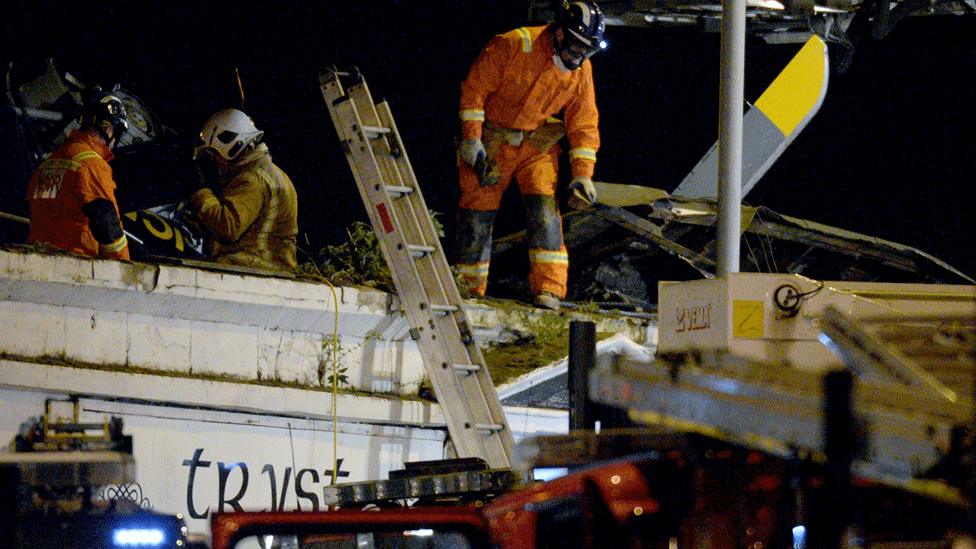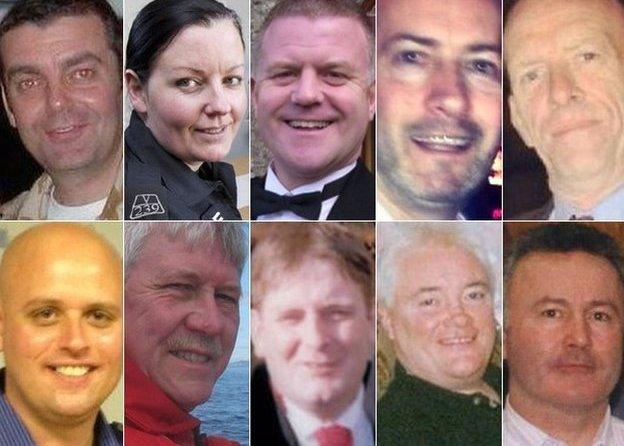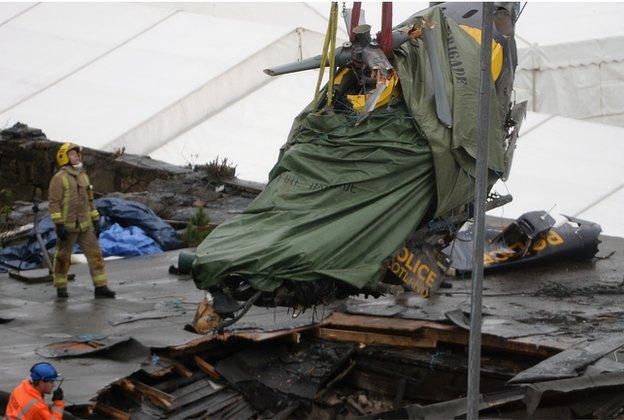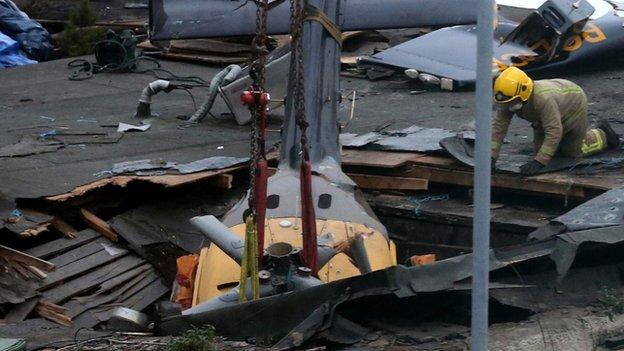At-a-glance: What caused the Clutha helicopter crash?
- Published

Three people in the helicopter and a further seven in the pub were killed
An Air Accident Investigation Branch report into the helicopter which crashed into the Clutha bar in Glasgow killing 10 people has said it came down for "unknown reasons".

The police helicopter crashed through the roof of the packed bar at 22:22 on 29 November 2013.
It had left Glasgow at 20:44 and travelled to the south of Glasgow and then to Dalkeith in Midlothian.
It was just 2.7 nautical miles from returning to Glasgow City Heliport when the engines flamed out.
The helicopter descended at a high rate on to the roof of the Clutha Bar, which collapsed.


A police helicopter crashed into the Clutha Bar in Glasgow
What happened to the helicopter on the night?
Fuel in the helicopter's main fuel tank is pumped into a supply tank, which is divided into two cells.
Each cell of the supply tank feeds its respective engine.
It was found that there was 76kg of fuel in the main fuel tank but the supply tank was empty at the time of impact.
Investigators worked out that both fuel transfer pumps in the main tank had been selected "off" for a sustained period before the accident, leaving the fuel in the main tank, unusable.
The report said that "despite extensive analysis of the limited evidence available, it was not possible to determine why both fuel transfer pumps in the main tank remained off during the latter part of the flight".
It also could not work out why the helicopter did not land within 10 minutes of the low fuel warnings and why a MAYDAY call was not received from the pilot.


Clutha victims: (Top: left to right) David Traill; Pc Kirsty Nelis; Pc Tony Collins; Gary Arthur; Samuel McGhee (Bottom: left to right) Colin Gibson; Robert Jenkins; Mark O'Prey; John McGarrigle; Joe Cusker
What are the report's conclusions?
The report says the helicopter took off with about 400kg of fuel.
It says the helicopter flew from Glasgow to Dalkeith and at some point on the way back the both main tank fuel transfer pumps were off.
The report says there was no evidence to indicate that the fuel contents display system was operating incorrectly.
Low fuel warnings were triggered during the flight. It was estimated that this occurred before the helicopter reached Bothwell in South Lanarkshire.
The low fuel warnings were acknowledged five times.
The helicopter did not land within 10 minutes of the activation of a continuous low fuel warning.
Both engines flamed out due to fuel starvation, about 32 seconds apart.
The radio altimeter and the landing light ceased to be powered following the second engine flameout.
No significant pre-impact technical defect was identified in any part of the aircraft or its systems.
There was no usable fuel in the supply tank cells when the engines flamed out.
There was 76kg (73kg usable) of fuel in the main tank when the engines flamed out.


Rescuers lift the police helicopter wreckage from the roof of The Clutha pub
What caused the crash?
Investigators identified a number of "causal factors" in the crash.
They said there was 73kg of usable fuel in the main tank but it became unusable as a result of the fuel transfer pumps being switched off for "unknown reasons".
The helicopter did not land within the 10-minute period specified in the Pilot's Checklist Emergency and Malfunction Procedures, following continuous activation of the low fuel warnings. Again the reasons for this were "unknown".
Both engines flamed out sequentially while the helicopter was airborne, as a result of fuel starvation, due to depletion of the supply tank contents.
A successful autorotation and landing was not achieved, for "unknown reasons".

What other factors contributed to the crash?
Incorrect management of the fuel system. Useable fuel was allowed to remain in the main tank while the contents in the supply tank become depleted.
The RADALT and steerable landing light were unpowered after the second engine flamed out, leading to a loss of height information and reduced visual cues.
Both engines flamed out when the helicopter was flying over a built-up area.

What recommendations were made in the report?
It recommends that the Civil Aviation Authority requires all Police helicopters to be equipped with a "black box" recorder capable of capturing data, audio and images in crash-survivable memory.
It also recommends that the European Aviation Safety Agency make flight recorders mandatory for all helicopter emergency medical service operations.
- Published23 October 2015

- Published21 October 2015
